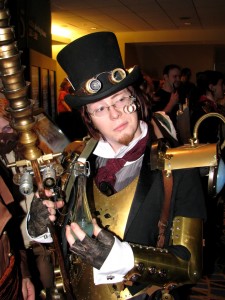So for reasons that I don’t quite understand and can’t completely articulate, I’ve recently been drawn to the time period about 100-150 years ago.
Maybe it started with some of the research for Connecticut Jerks and/or my fascination with Abraham Lincoln, and then has been fueled by the discovery of my strong resemblance to my great-great-grandfather, but I suddenly find that era very compelling—and not for the steampunk potential, either.
In 2001, historian Roger Ekirch of Virginia Tech published a seminal paper, drawn from 16 years of research, revealing a wealth of historical evidence that humans used to sleep in two distinct chunks.
His book At Day’s Close: Night in Times Past, published four years later, unearths more than 500 references to a segmented sleeping pattern – in diaries, court records, medical books and literature, from Homer’s Odyssey to an anthropological account of modern tribes in Nigeria.
Much like the experience of Wehr’s subjects, these references describe a first sleep which began about two hours after dusk, followed by waking period of one or two hours and then a second sleep.
“It’s not just the number of references – it is the way they refer to it, as if it was common knowledge,” Ekirch says.
Anyway, in addition to looking at the earliest photographic images I can find, I also have been increasingly viewing YouTube clips like this.
Yes, that was from a century ago, which is remarkable to me—both in the sense that we have moving images from 100 years ago and that life seemed to be so very different than it was now.
I think it’s safe to say that our world has changed more from 1912 to 2013 than in any other 101-year span that you can pick in all of human history—in that time frame we’ve gone to the moon, split the atom, eradicated smallpox, broke the sound barrier, transplanted hearts and created technology that puts almost everything known to Man in the palm of your hand. And that’s really a fraction of what’s happened.
When I look at these images, it seems that the human race has physically changed, too. Yes, we’re more obese than ever, but we’re also living longer and despite illnesses associated with excess, are in better health. Kids are not dropping dead from polio any more, you know, unless they live in a part of the world where forward-thinking humanitarian warlords have banned immunizations to further their own agenda, or are one of Jenny McCarthy’s immunization-free kids.
Currently, the American life expectancy is 78.7 years; in 1912, it was 53.9 years, so on average we’re living 25 years longer than ever before—a full quarter century, which is astonishing. Again, with all due respect to natural selection and evolution, I doubt there has ever been such a jump in that aspect of homo sapiens in such a short period. I’m surprised that we haven’t gotten whiplash from such an abrupt change …
Then again, looking at the way we live at times and things we choose on which to focus, maybe we have.
Anyway, part of my curiosity has also been stoked by watching classic films on TCM—primarily the oldest pictures that are available. The other night I was watching Ah, Wilderness from 1935, which itself depicts life in 1906.
So many odd little quirks and things that seem to have been forgotten by history … in one scene, one of the characters sits down at the breakfast table, takes his cup of coffee and pours it into his saucer and drinks it out of that—and apparently, that was perfectly acceptable behavior for the time.
I saw The Searchers another night—it was interesting the way the handled horses, how they only rode them for a while, then walked them for a while. You don’t really see that practice in modern westerns, but it was standard operating procedure.
I’ve also watched silent films featuring Charlie Chaplin and Buster Keaton, and although they play exaggerated characters, I’m reminded at how few possessions people had up until recently—usually one suit, one hat, one pair of shoes (maybe borrowed from someone else). Sure, in films about bygone eras we might see lavish costumes, but the reality was that for the vast majority of humanity, fashion was not a concern.
But other key points of our daily routines have been lost in the shifting sands of time, too. Outside of film, I recently read about how all of humanity used to have two sleep periods per night. In fact, it was such an accepted part of life, that no one even really commented on it at the time. Here’s an excerpt from the article link in the previous sentence:
In 2001, historian Roger Ekirch of Virginia Tech published a seminal paper, drawn from 16 years of research, revealing a wealth of historical evidence that humans used to sleep in two distinct chunks.
His book At Day’s Close: Night in Times Past, published four years later, unearths more than 500 references to a segmented sleeping pattern – in diaries, court records, medical books and literature, from Homer’s Odyssey to an anthropological account of modern tribes in Nigeria.
Much like the experience of Wehr’s subjects, these references describe a first sleep which began about two hours after dusk, followed by waking period of one or two hours and then a second sleep.
“It’s not just the number of references – it is the way they refer to it, as if it was common knowledge,” Ekirch says.
Amazing, right?
I wonder what things we take for granted will be forgotten by future generations … like the keyboard on which I’m typing? Rotary phones? Pogs? If things go as they’re supposed to, I’ll never know … probably.

